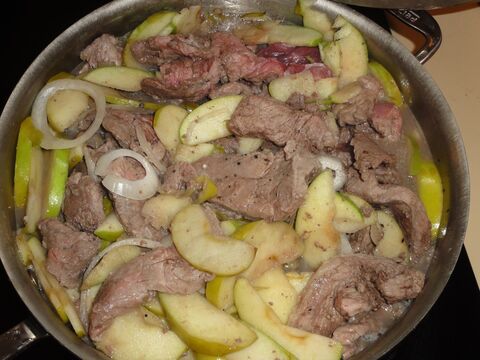
Despite its title, this dish isn't much like a modern stew of pieces of meat, fowl, or fish simmered along with vegetables in a rich broth or gravy. It's more like a seventeenth- or eighteen-century hash, which, as we explain in Northern Hospitality, was an elegant preparation of thinly sliced meat. Beecher's recipe calls for beef or veal, cut "in thin slices," and apple "sliced fine."
We confess that we thought this might be a rather bland dish. It was a popular preparation right into the nineteenth century, which is why we included it in our book. But there is so little to it--just sliced beef or veal, apples, a bit of onion, salt, pepper, and some butter to coat the pan. Our fears were unfounded. Cooked slowly together, these unassuming ingredients achieve unexpected flavor and complexity. The juices released by the apple slices as they cook (we used Granny Smiths) soften the beef perfectly while giving it character; the onion, salt, and pepper bring out the natural flavors of the ingredients. With the addition of some cooked white rice and steamed winter vegetables, we had a pleasing supper.
Our Version of Miss Beecher's Beef, or Veal Stewed with Apples (Very Good)
Serves 6
Ingredients
2 tablespoons butter
3.5 lbs. top round of beef, thinly sliced
6 Granny Smith Apples, peeled, cored, and thinly sliced
1 medium yellow onion, peeled and thinly sliced
Salt and pepper
To make our stewed beef and apples, we used a 10.5-inch (3 quart) stainless steel sauté pan with a lid. We began by coating the cold pan with two tablespoons of butter. We put in the slices of beef, apples, and onions in alternating layers. We sprinkled a bit of sea salt between each layer, along with some freshly ground black pepper.
We covered the pan and stewed the beef and apples on low heat. After the mixture had cooked for about 45 minutes, we uncovered it and stirred it once, then turned the burner up just a little to low medium. (Our electric stove offers minute gradations in burner temperature, such as low-medium. If yours does not, you can cook the entire dish slowly on low heat. The slower the better, actually.) We covered it again and simmered it for another hour and fifteen minutes. Keeping the dish covered and stirring only occasionally helps to retain the moisture that softens the beef. This long, slow, moist form of cooking is also called braising. After two hours, we uncovered the pan to find a mellow, appetizing blend of cooked apples and beef. The total cooking time was two hours.
Note: Any firm apple can be used in this dish.
(Recently, we deployed to great success a locally grown Pippin in another dish we were making. Pippins are slightly tart, firm apples that ripen in late fall in New England. They're still easy to find in the UK, but harder to find here. We hope they'll become popular again here as they're delicious to eat and great to cook with. Look for them at farmers' markets and local orchards. Ask your local orchard to consider growing them.) The Pippin would have held up perfectly in this beef and apple dish too. But a softer eating apple, such as the MacIntosh, would not have worked so well--the meat must stew gently for a long time, and the apple must be able to hold up to this length of cooking without becoming pure liquid.
As for choosing the piece of beef or veal, we recommend using a relatively inexpensive cut, such as the top round. It is perfectly suited to being cooked slowly with moist heat.
Finally, be sure your pan is large enough to hold all of the raw ingredients easily. It should have a thick, sturdy bottom so that hot spots don't develop during the long cooking process.
The original recipe, with commentary, can be found in Northern Hospitality, p. 237.